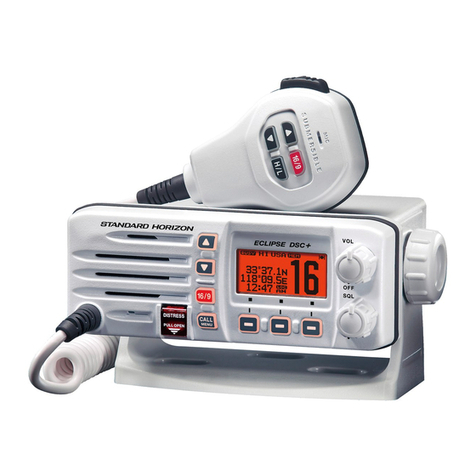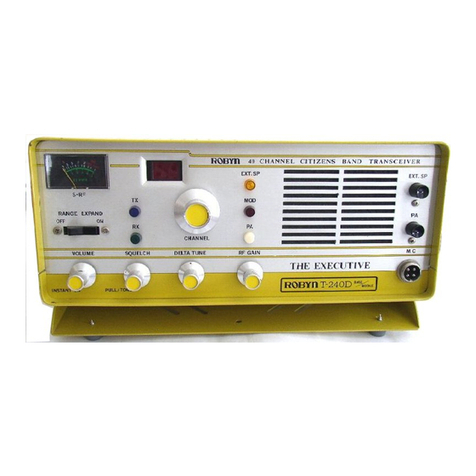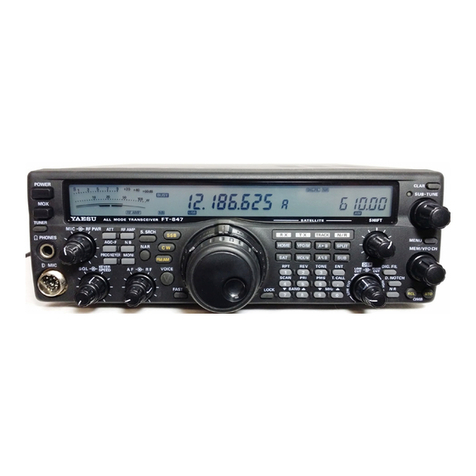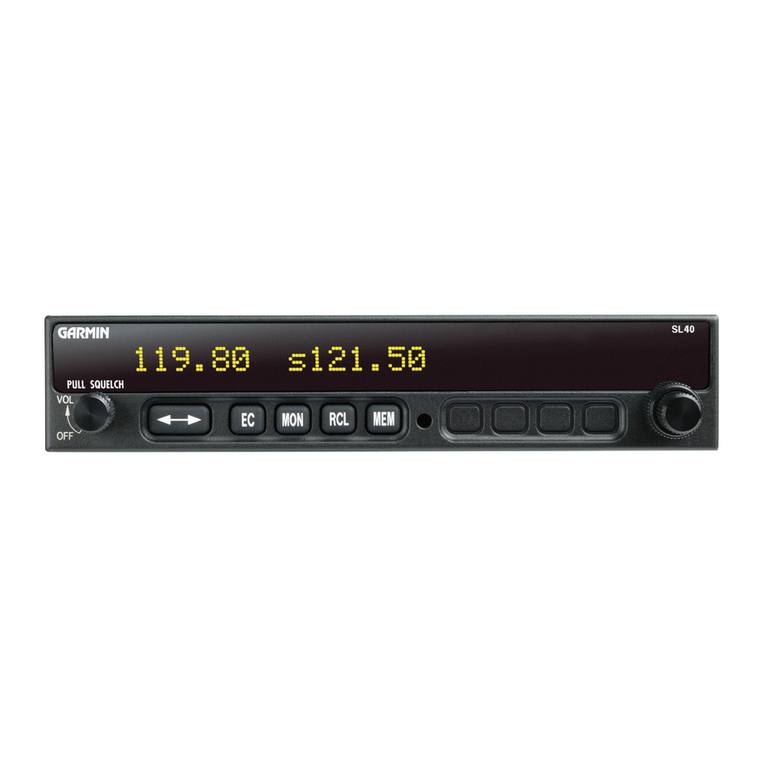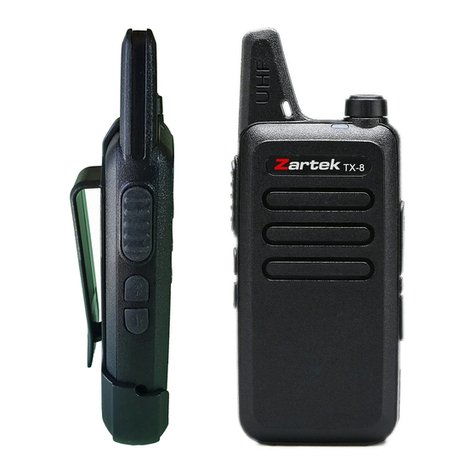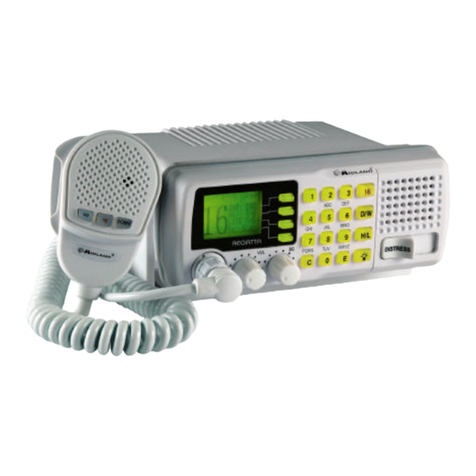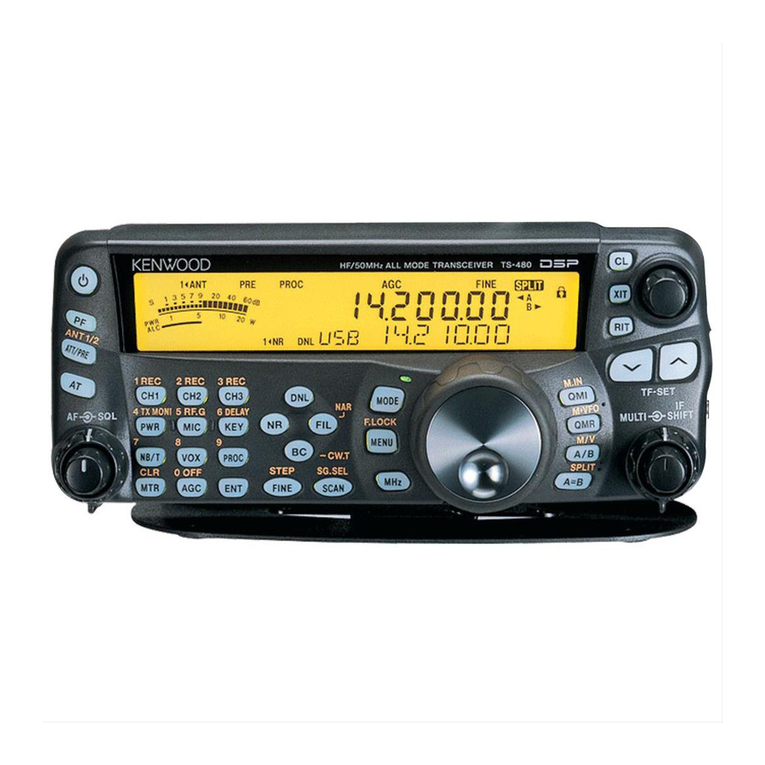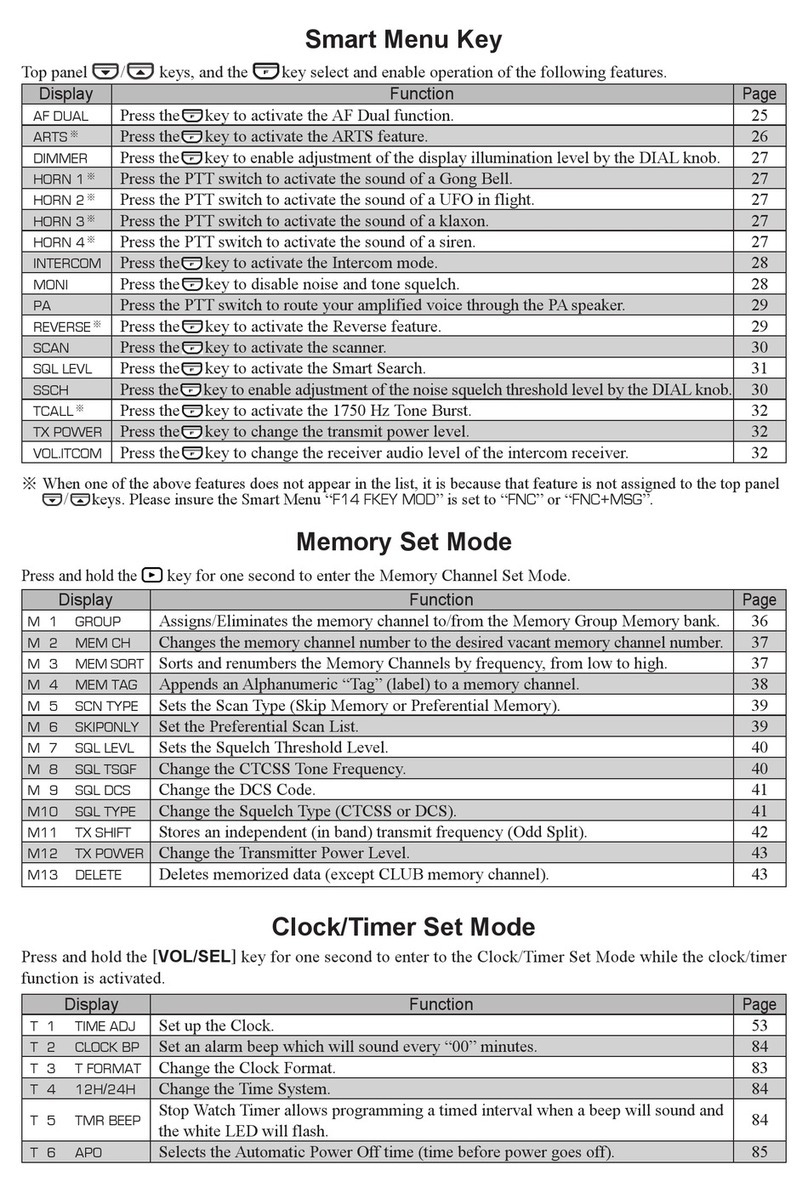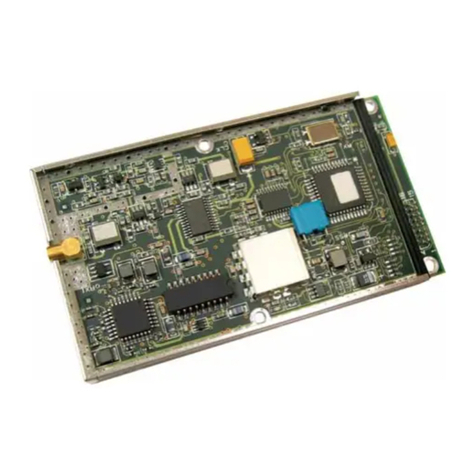iGAZE TCOO900 User manual

iGAZE®RE KIT
Transceiver System for Mechanical, 10kΩ, or 8.2kΩ
Resistive Safety Edges
INSTRUCTION MANUAL
v.5.23.17
Movable Device
TCOO900
Fixed Device
RCOO900
BI-DIRECTIONAL
COMMUNICATION
UL 325
Recognized
Component

BELOW IS THE MOST COMMON INSTALLATION
TRANSCEIVER SYSTEM FOR SAFETY EDGES
Resistive edge 2
TCOO900 - Both safety edges are 8.2kΩ
or 10kΩ resistive
DIP1 ON:
resistive safety edge 8.2kΩ/10kΩ 1
resistive safety edge 8.2kΩ/10kΩ 2
If you want to connect a resistive edge on the input Safety1 (8.2kΩ/10kΩ resisitor), you
must set dip switch 1 to «ON».
(8.2kΩ/10kΩ resistor ), you
must set dip switch 2 to «ON».
DIP2 ON:
If you want to connect a resistive edge on
the input Safety2
DIP6: Not Used
Led and
programming /
test key 2
Dip switch
Led and
programming /
test key 1
Resistive edge 1 8.2kΩ(N.C.)
Resistive edge 2 8.2kΩ
/10kΩ
/10kΩ
(N.C.)
F
Frequency
Low Power
Safety2 Type
Safety1 Type
Safety2
Safety1 Resistive edge 1
1 2 3 4 5 6
configuration
Prog/Test2Prog/Test1
DIP
ON
OFF
Movable device name TCOO900
Fixed device name RCOO900
Frequency 902-928 Mhz
Range of the system in free space 20 m / 60 feet
TCOO9000 power supply 2 x 1.5V batteries (AA)
RCOO900 power supply 12/24 Vac-dc
Battery duration 2 years (no
Minimum battery level (TCOO900) 1.9V
rmal functioning mode). 5 years (Low Power mode).
Compatible safety edges (TCOO900) Mechanical (N.C. o N.O.) and/or resistive
(8.2 kΩ/10kΩ).
Number of outputs (RCOO900) 2
Maximum number of Transmitters for each RCOO900 8 for each device.
Maximum number of safety edges for each output 8 for each
Power draw on RCOO900 (24Vdc) 25mA (standby)
28 mA (one relay engaged)
50mA (two relays engaged)
Resistive Safety Edge (max value) 5kOhm < R < 20KOhm (safety edge OK)
R<5KOhm (safety edge in short circuit)
R>20KOhm (OPEN safety edge)
50-60Hz
Frequency for alternate current (RCOO900)
relay.
-10°C to +55°C / 14°F to 131°F
Operating Temperature
TECHNICAL SPECIFICATIONS
QUICK START GUIDE
2
RCOO900 - 10kΩoutput on both
relay 1 and relay 2.
Output relay
0.5A a 42.4Vac
1A a 30Vdc
Buzzer
Dip Switch
To Operator To Operator
Programming/
Reset Key
OFF ON
2 1
4 3
5
6
12/24
Vac/dc
C1
NC1
NO1
C2
NC2
NO2
10k2 10k2
Test1
Test2
TestC.
Test Polarity
Buzzer OFF
Frequency
Out1 10k2
Out2 10k2
ROO900

SAFETY 1 INPUT
Mechanical safety edge (N.C./N.O.)
Resistive safety edge 8.2kΩ / 10kΩMechanical safety edge (N.C./N.O.)
SAFETY 2 INPUT
Mechanical safety edge (N.C./N.O.)
Mechanical safety edge (N.C./N.O.) Resistive safety edge
STEP 1
OPTION 1
Refer to Example 1
Table 1
OPTION 2 OPTION 3 OPTION 4
WARNING: If you use mechanical safety edges, both safety edges must be configured the same with either a normally
open contact, or a normally closed contact.
The iGAZE®RE transceiver system is intended as a safety device for automated gates and rolling doors. The system is
comprised of 1 fixed device (RC00900) with 2 output relays, which is connected to the operator, and up to 8 movable
devices (TC00900) for each relay. The system TCOO900 will accept safety edges with the following outputs: Mechani-
cal edges with a N.O. or N.C. output, 10kΩ or 8.2kΩ Resistive edges. The fixed device also has 2 controls to perform
an “Auto-test” for operators that have this feature. The transmission signal is bi-directional and utilizes the frequencies
902-928MHz. Maximum range between the movable and fixed devices is 60 feet.
TCOO900 is suitable for outdoor use. RCOO900 is suitable for indoor use only (“indoor” means inside the
operator box. ) The installation of the system must be carried out by a qualified installer.
CONNECT THE SAFETY EDGE TO THE SAFETY EDGE MOVABLE DEVICE (TCOO900)
It is possible to connect multiple safety edge technologies into each safety edge movable device within certain
conditions as shown in Table 1.
STEP 2
SET THE DIP SWITCHES OF THE
TCOO900 TO CORRESPOND TO
THE EDGE CONFIGURATION YOU
HAVE CHOSEN ACCORDING TO
THE CONDITIONS OF TABLE 1 AND
PER THE FOLLOWING EXAMPLES:
A
DESCRIPTION
B
CONFIGURATION AND ELECTRICAL CONNECTIONS
Resistive edge 2
EXAMPLE 1 - Both safety edges are 8.2kΩ or 10kΩ resistive (MOST COMMON INSTALLATION)
N° DIP Function
1 Mechanical (OFF) or resistive (ON) edge 1.
2 Mechanical (OFF) or resistive (ON) edge 2.
3 Low Power (see Section E on page 11).
4
5
6 Mechanical edge with N.C. contact (OFF) or
Mechanical edge with N.O. contact (ON)
Frequency channel selection (see page 6)
TCOO900
(All switches in example
above are set to OFF)
DIP
ON
OFF
1 2 3 4 5 6
DIP1 ON:
resistive safety edge 8.2kΩ/10kΩ 1
resistive safety edge 8.2kΩ/10kΩ 2
If you want to connect a resistive edge on
the input Safety1 (8.2kΩ/10kΩ resisitor), you
must set dip switch 1 to «ON».
(8.2kΩ/10kΩ resistor ), you
must set dip switch 2 to «ON».
DIP2 ON:
If you want to connect a resistive edge on
the input Safety2
DIP6: Not Used
Led and
programming /
test key 2
Dip switch
Led and
programming /
test key 1
Resistive edge 1 8.2kΩ(N.C.)
Resistive edge 2 8.2kΩ
/10kΩ
/10kΩ
(N.C.)
F
Frequency
Low Power
Safety2 Type
Safety1 Type
Safety2
Safety1 Resistive edge 1
1 2 3 4 5 6
configuration
Prog/Test2Prog/Test1
DIP
ON
OFF
8.2kΩ / 10kΩ
Resistive safety edge 8.2kΩ/ 10kΩ
Resistive safety edge 8.2kΩ/ 10kΩ
3

EXAMPLE 2 - Both safety edges are normally closed.
Warning: This configuration does not meet the current UL-325-2016 standard, but is accepted for older
installations installed before 2016.
DIP6 OFF: mechanical safety edge N.C.
If you want to use a mechanical safety edge with
a normally closed contact, you must set dip
switch 6 to «OFF».
Dip switch
Resistive edge 1
Safety2
Safety1
Mechanical edge 2 (N.C.)
Dip switch
Mechanical edge 1 (N.O.)
Mechanical edge 2 (N.O.)
Safety2
Safety1
DIP1 OFF: mechanical safety edge 1
If you want to connect a mechanical edge on
the input Safety1 (normally open
open
contact), you
must set dip switch 1 to «OFF».
DIP2 OFF: mechanical safety edge 2
If you want to connect a mechanical edge on
the input Safety2 (normally contact), you
must set dip switch 2 to «OFF».
DIP6 ON: mechanical safety edge
If you want to use a mechanical safety edge with a
normally open contact, you must set dip
switch 6 to «ON».
EXAMPLE 3 - Both safety edges are normally open.
EXAMPLE 4 - Safety edge with 8.2kΩ or 10kΩ resistive edge on input 1 and mechanical safety edge
with a Normally Closed output on input 2.
Led and
programming /
test key 2
Led and
programming /
test key 1
F
Frequency
Low Power
Safety2 Type
Safety1 Type
1 2 3 4 5 6
configuration
Prog/Test2Prog/Test1
DIP
ON
OFF
Led and
programming /
test key 2
Led and
programming /
test key 1
F
Frequency
Low Power
Safety2 Type
Safety1 Type
1 2 3 4 5 6
configuration
Prog/Test2Prog/Test1
DIP
ON
OFF
DIP1 ON:
resistive safety edge 8.2kΩ/10kΩ 1
If you want to connect a resistive edge on
the input Safety1 (8.2kΩ/10kΩ resistor ), you
must set dip switch 1 to «ON».
Resistive edge 1 8.2kΩ(N.C.
/10kΩ
DIP1 OFF: mechanical safety edge 1
If you want to connect a mechanical edge on
the input Safety1 (normally closed contact), you
must set dip switch 1 to «OFF».
DIP2 OFF: mechanical safety edge 2
If you want to connect a mechanical edge on
the input Safety2 (normally closed contact), you
must set dip switch 2 to «OFF».
DIP6 OFF: mechanical safety edge N.C.
If you want to use a mechanical safetyedge with a
normally closed contact, you must set dip
switch 6 to «OFF».
Led and
programming /
test key 2
Dip switch
Led and
programming /
test key 1
Mechanical edge 1 (N.C.)
Mechanical edge 2 (N.C.)
F
Frequency
Low Power
Safety2 Type
Safety1 Type
Safety2
Safety1
1 2 3 4 5 6
configuration
Prog/Test2Prog/Test1
DIP
ON
OFF
DIP2 OFF: mechanical safety edge 2
If you want to connect a mechanical edge on
the input Safety2 (normally closed contact), you
must set dip switch 2 to «OFF».
4

DIP6 ON: mechanical safety edge
If you want to use a mechanical safety edge with
a normally closed contact, you must set dip
switch 6 to «ON».
Dip switch
Resistive edge 1
Safety2
Safety1
EXAMPLE 5 - TCOO900 with mechanical safety edge N.C. on input 1 and 8.2kΩ or 10kΩ
resistive edge on input 2
EXAMPLE 6 - 8.2kΩ or 10kΩ resistive edge on input 1 and normally open on input 2
DIP1 OFF: mechanical safety edge 1
If you want to connect a mechanical edge on
the input Safety1 (normally open contact), you
must set dip switch 1 to «OFF».
DIP2 ON
: resistive
safety edge
8.2kΩ
/10kΩ
2
If you want to connect a resistive edge on the
input Safety2 (8.2kΩ/10kΩresistor), you must
set dip switch 2 to «ON».
DIP6 ON: mechanical safety edge
If you want to use a mechanical safety edge with
a normally open contact, you must set dip
switch 6 to «ON».
Dip switch
Resistive edge 2
Safety2
Safety1
Mechanical edge 1 (N.O.)
EXAMPLE 7 - Normally open edge on input 1 and 8.2kΩ or 10kΩ resistive edge on input 2
Led and
programming /
test key 2
Led and
programming /
test key 1
F
Frequency
Low Power
Safety2 Type
Safety1 Type
1 2 3 4 5 6
configuration
Prog/Test2Prog/Test1
DIP
ON
OFF
Led and
programming /
test key 2
Led and
programming /
test key 1
F
Frequency
Low Power
Safety2 Type
Safety1 Type
1 2 3 4 5 6
configuration
Prog/Test2Prog/Test1
DIP
ON
OFF
WARNING:
DIP1 OFF: mechanical safety edge 1
If you want to connect a mechanical edge on
the input Safety1 (normally closed contact), you
must set dip switch 1 to «OFF».
DIP2 ON
: resistive safety edge 8,2k
Ω/10kΩ
2
If you want to connect a resistive edge on the
input Safety2 (8.2kΩ/10kΩresistor), you must
set dip switch 2 to «ON».
DIP6 OFF: mechanical safety edge
If you want to use a mechanical safety edge with
a normally closed contact, you must set dip
switch 6 to «OFF».
Dip switch
Resistive edge 2
Safety2
Safety1
Mechanical edge 1 (N.C.)
Led and
programming /
test key 2
Led and
programming /
test key 1
F
Frequency
Low Power
Safety2 Type
Safety1 Type
1 2 3 4 5 6
configuration
Prog/Test2Prog/Test1
DIP
ON
OFF
Resistive edge 2 8.2kΩ/10kΩ(N.C.)
Resistive edge 2 8.2kΩ/10kΩ(N.C.)
Resistive edge 2 8.2kΩ/10kΩ(N.C.)
Mechanical edge 2 (N.O.)
DIP1 ON:
resistive safety edge 8.2kΩ/10kΩ 1
If you want to connect a resisitive edge on
the input Safety1(8.2kΩ/10kΩ resisitor), you
must set dip switch 1 to «ON».
open
DIP2 OFF: mechanical safety edge 2
If you want to connect a mechanical edge on
the input Safety2 (normally contact), you
must set dip switch 2 to «OFF».
5

Height min: 8”
POWER THE TCOO900 BY INSTALLING THE TWO AA BATTERIES (1.5V)
INTO THE BATTERY HOLDER. PLEASE NOTE THE CORRECT POLARITY.
MOUNT THE TCOO900 AS HIGH AS POSSIBLE
AND IN SUCH WAY AS THERE ARE NO OBSTA-
CLES IN THE DIRECTION OF THE RCOO900 AND
IN SUCH A WAY AS THE MAXIMUM DISTANCE
BETWEEN THE TWO DEVICES IS LESS THAN
60 FEET (MAX 20 METERS / 60 FEET).
WARNING: install the TCOO900 at a
minimum height of 8” from the ground.
Keep the installation area clean of debris
which can effect the normal operation of
the system.
NOTE: Transmitter Solutions is not
responsible for any damage caused by an
improper, incorrect, or unintended use of the product.
Height
min: 8”
RCOO900
TCOO900
DIP
ON
OFF
1 2 3 4 5 6
DIP
ON
OFF
1 2 3 4 5 6
N° DIP Function
1 Mechanical (OFF) or resistive (ON) edge 1.
2 Mechanical (OFF) or resistive (ON) edge 2.
3 Low Power. (see Section E on page 11)
4
5
6 Mechanical edge with N.C. contact (OFF) or
Mechanical edge with N.O. contact (ON)
Frequency channel selection
SET DIP SWITCHES 4 AND 5 ON THE TCOO900 AND 3 AND 4 ON THE RCOO900 TO THE SAME
SETTINGS.
Frequency channel selection
N° DIP Function
1 Test device.
2 Buzzer ON / OFF.
3
4
5 NO1 output: N.O. contact (OFF) or 8k2
signal (ON) 1.
6 NO1 output: N.O. contact (OFF) or 8k2
signal (ON) 2.
STEP 3
STEP 4
STEP 5
It is possible to associate a maximum of 8 TCOO900 to
each RCOO900.
WARNING: for a correct functioning of the system,
every TCOO900 must have the frequency dip switch set
the same way as the corresponding RCOO900.
On a safety system with more than one Receiver, to avoid interference, we recommend the use of different frequency
settings on each set of a RCOO900 and the associated TCOO900.
1.5V
1.5V
Frequency channel selection
6
Channel
1
2
3
4
Dip 3(4)
OFF
OFF
ON
ON
Dip 4(5)
OFF
ON
OFF
ON
Frequency (MHz)
912.900
914.900
916.900
918.900

EXAMPLE 1 - 10kΩoutput on both
relay 1 and relay 2.
EXAMPLE 2 - Normally closed outputs on both
relay 1 and relay 2.
MOUNT THE RCOO900 AS CLOSE AS POSSIBLE TO THE TCOO900. IF MOUNTED TO A WALL,
USE SUITABLE SCREWS AND ANCHORS TO SECURE THE RCOO900.
DEPENDING ON THE TYPE OF SIGNAL REQUIRED, CONNECT THE OUTPUTS AS EXPLAIN IN THE
FOLLOWING TABLE, AND ACCORDING TO THE FOLLOWING EXAMPLES.
WARNING: The power supply
for the receiver must be an
insulated transformer to protect
against short circuits.
OUTPUT SIGNAL TERMINAL
BOARD
SETTING OF
DIP SWITCH
N.C. contact NC1-C1 ( NC2-C2) -
N.O. contact NO1-C1 ( NO2-C2) DIP5 OFF (DIP6 OFF)
10kΩresistive NO1-C1 ( NO2-C2) DIP5 ON (DIP6 ON)
NOTE: The signals given on the outputs to relay 1 and 2 are a N.C. contact and a N.O. contact or a N.C. contact
and a resistive output (10kΩ), depending on the setting of dip switches 5 and 6, and the wiring connection.
NOTE: The level of acoustic noise generated by the device is less then 70 dBA.
Output relay
0.5A a 42.4Vac
1A a 30Vdc
Buzzer
Dip Switch
To Operator To Operator
Programming/
Reset Key
OFF ON
2 1
4 3
5
6
12/24
Vac/dc
C1
NC1
NO1
C2
NC2
NO2
10k2 10k2
Test1
Test2
TestC.
Test Polarity
Buzzer OFF
Frequency
Out1 10k2
Out2 10k2
RCOO900
Output relay
0.5A a 42.4Vac
1A a 30Vdc
Buzzer
Dip Switch
To Operator To Operator
Programming/
Reset Key
OFF ON
2 1
4 3
5
6
C1
NC1
NO1
C2
NC2
NO2
10k2 10k2
Test1
Test2
TestC
Test Polarity
Buzzer OFF
Frequency
Out1 10k2
Out2 10k2
RCOO900
STEP 7
STEP 6
12/24
Vac/dc
Table 2
7

EXAMPLE 3 - Normally open outputs on
both relay 1 and relay 2.
EXAMPLE 4 - Normally closed output
on relay 1 and 10kΩ resistive
routput on relay 2.
EXAMPLE 5 - 10kΩresistive output on
relay 1 and normally
closed output on relay 2.
MOUNT THE IGAZE®RE RCOO900 POWER THE RCOO900 WITH 12-24 VAC/DC
INSULATED POWER SUPPLY (NOT INCLUDED
WITH THE IGAZE®RE KIT).
Output relay
0.5A a 42.4Vac
1A a 30Vdc
Buzzer
Dip Switch
To Operator To Operator
Programming/
Reset Key
OFF ON
2 1
4 3
5
6
C1
NC1
NO1
C2
NC2
NO2
10k2 10k2
Test1
Test2
TestC
Test Polarity
Buzzer OFF
Frequency
Out1 10k2
Out2 10k2
RCOO900
Output relay
0.5A a 42.4Vac
1A a 30Vdc
Buzzer
Dip Switch
To Operator To Operator
Programming/
Reset Key
OFF ON
2 1
4 3
5
6
C1
NC1
NO1
C2
NC2
NO2
10k2 10k2
Test1
Test2
TestC
Test Polarity
Buzzer OFF
Frequency
Out1 10k2
Out2 10k2
RCOO900
Output relay
0.5A a 42.4Vac
1A a 30Vdc
Buzzer
Dip Switch
To Operator To Operator
Programming/
Reset Key
OFF ON
2 1
4 3
5
6
C1
NC1
NO1
C2
NC2
NO2
10k2 10k2
Test1
Test2
TestC
Test Polarity
Buzzer OFF
Frequency
Out1 10k2
Out2 10k2
RCOO900
NOTE: This configuration does not meet the
current UL 325-2016 requirement because it
cannot be monitored.
STEP 8 STEP 9
12/24
Vac/dc
12/24
Vac/dc
12/24
Vac/dc
8

PROGRAMMING OF THE MOVABLE DEVICE ON RELAY 1 OF THE FIXED DEVICE
PROGRAMMING OF THE TRANSMITTER ON RELAY 2 OF THE FIXED DEVICE
2RCOO900 emits 1BEEP.
3
4
Press and keep pressed the programming/
reset button on the RCOO900.
RCOO900.
Press and keep pressed t
he programming/reset
used input. Prog/Test1 for safety edge 1, Prog/Test2 for safety edge 2.
Release the programming/reset button on the
TCOO900.
Release the programming/reset button on the
RCOO900 emits 2BEEPS.(*)
1
Check that the DIP 4 and 5 of the TCOO900
and DIP 3 and 4 of the RCOO900
are set the same way.
button on the TCOO900 relative to the
5Programming has succeeded.
PROGRAM THE TCOO900 TO THE RCOO900 ACCORDING TO THE FOLLOWING INSTRUCTIONS:
To enter more TCOO900 in the RCOO900, repeat the operation from step 2. (on page 2)
(*) If you hear 4 BEEPS, it means that the maximum number of safety edges for the selected channel has been
reached and that no new devices on the same relay can be memorized.
NOTE: When the TCOO900 is used with two connected safety edges, it is necessary to carry out the learning
process two times, one for each input.
WARNING: The same output of the TCOO900 can be memorized on both relays. To erase the memorized
input it is necessary to perform a complete reset of the RCOO900 (see page 9).
To enter more TCOO900 in the RCOO900, repeat the operation from step 2. (on page 2)
(*) If you hear 4 BEEPS, it means that the maximum number of safety edges for the selected channel has been
reached and that no new devices on the same relay can be memorized.
NOTE: When the TCOO900 is used with two connected safety edges, it is necessary to carry out the learning
process two times, one for each input.
WARNING: The same output of the TCOO900 can be memorized on both relays. To erase the memorized
input it is necessary to perform a complete reset of the RCOO900 (see spage 9).
2
RCOO900 emits 1BEEP.
3
4
Press and keep pressed the programming/
reset button on the RCOO900.
RCOO900.
Press and keep pressed the programming/reset
used input. Prog/Test1 for safety edge 1, Prog/Test2 for safety edge 2.
Release the programming/reset button on the
TCOO900.
Release the programming/reset button on the
RCOO900 emits 2BEEPS.(*)
1
Check that the DIP 4 and 5 of the TCOO900
and DIP 3 and 4 of the RCOO900
are set the same way.
button on the TCOO900 relative to the
5Programming has succeeded.
RCOO900 emits 2BEEPS.
C
PROGRAMMING
STEP 10
9

Using the program/reset key, it is possible to erase all TCOO900 that are programmed into the RCOO900.
NOTE: This proceedure resets all memory to factory defaults.
D
RECEIVER RESET
2
RCOO900 emits 1BEEP
3
4
Press and keep pressed the programming/
reset button on the RCOO900.
on the RCOO900.
DO NOT RELEASE
the programming/reset button
on the RCOO900.
DO NOT RELEASE
the programming/reset button
on the RCOO900.
DO NOT RELEASE
the programming/reset button
RCOO900.
Release the programming/reset button on the
RCOO900
emits 2
BEEPS
RCOO900
emits a series of rapid BEEPS.
RCOO900
emits a continuous BEEP.
RCOO900 The reset is
emits 6 BEEPS.
1
5complete.
Number of BEEP/
BLINK
Meaning
1 Regular functioning, no mistake found.
2 One or more safety edges faulty.
3 One or more
8.2k
/10k resistive edges disconnected.
Acoustic signaling during the normal functioning
4 Battery level low.
5 Low battery.
6 One or more associated devices disconnected
What to do
-
Check the safety edge connections
Check the resistive edges connected
Substitute the batteries of the indicted device
Replace the batteries
Check each associated device
TEST THAT THE PROGRAMMING OF THE MOVABLE DEVICE WAS SUCCESSFUL.
VERIFY THE CORRECT FUNCTION OF EACH SAFETY EDGE, MOVABLE AND FIXED DEVICES
WITH THE OPERATOR INSTALLED.
On each TCOO900, two buttons, labeled “programming/test key”, and two leds are present. Pushing the program-
ming button of the edge to test during normal functioning (so not in programming) produces a signal that is sent
to the RCOO900 which closes the contact of the relay and responds to this signal with:
Note: If one TCOO900 is in the alarm state and it is necessary to open or close the operating device, press and
keep pressed the programming / test button of the TCOO900 in alarm at the same time the operating device is
activated to open or close.
STEP 11
STEP 12
WARNING: install the TCOO900 at a
minimum height of 8” from the ground.
Keep the installation area clean of debris
which can effect the normal operation of
the system.
NOTE: Transmitter Solutions is not
responsible for any damage caused by an
improper, incorrect, or unintended use of the product.
10

E
ENERGY SAVING (LOW POWER)
F
DEVICES TEST
G
FCC COMPLIANCE
With the dip switch set to low power it is important to remember that the TCOO900 will only check in with the RCOO900
every 15 seconds. If a power failure (dead battery) were to occur during this 15 second interval, the RCOO900 will only
signal an alarm after the 15 second interval has been reached.
TCOO900 Dip switch 3 set ON: (Low power activated) state of the transmitter is checked every 15 seconds.
TCOO900 Dip switch 3 set OFF: (Low power deactivated) state of the transmitter is checked each second.
Through dip switch 1 on the receiver it is possible to select the device test to be carried out with either a high or low logic
signal.
With Dip switch 1 ON: Test of the device is carried out with a low logic signal of 0Vdc between terminals TEST1 and TESTC.
With Dip switch 1 OFF: Test of the device is carried out with a high logic signal of 10Vdc to 24Vdc.
NOTE: TEST1 and TESTC are used to carry out a test for relay 1 - TEST2 and TESTC will carry out a test for relay 2 in the
same manner. If you do not want to use the device test feature place Dip1 to the OFF position.
FCC ID: SU7TCO900 and SU7RCO900
This device complies with part 15 of the FCC rules. Operation is subject to the following two conditions: (1) This device may not cause harmful
interference, and (2) this device must accept any interference received, including interference that may cause undesired operation.
IMPORTANT! Any changes or modifications not expressly approved by the party responsible for compliance could void the user’s authority to operate
this equipment.
NOTE: This equipment has been tested and found to comply with the limits for a Class B digital device, pursuant to part 15 of the FCC Rules. These
limits are designed to provide reasonable protection against harmful interference in a residential installation. This equipment generates, uses and can
radiate radio frequency energy and, if not installed and used in accordance with the instructions, may cause harmful interference to radio
communications. However, there is no guarantee that interference will not occur in a particular installation. If this equipment does cause harmful
interference to radio or television reception, which can be determined by turning the equipment off and on, the user is encouraged to try to correct the
interference by one or more of the following measures:
•Reorient or relocate the receiving antenna.
•Increase the separation between the equipment and receiver.
•Connect the equipment into an outlet on a circuit different from that to which the receiver is connected.
•Consult the dealer or an experienced radio/ TV technician for help.
FCC Radiation Exposure Statement
This equipment complies with FCC radiation exposure limits set forth for an uncontrolled environment. This equipment should be installed and
operated with minimum distance 20cm between the radiator and your body.
11

H
TROUBLESHOOTING
WARRANTY
The warranty period of this product is 24 months, beginning from the manufacturing date. During this period, if the product does not operate correctly, due to
a defective component, the product will be repaired or replaced at the sole discretion of Transmitter Solutions. This warranty does not extend to the product
casing which can be damaged by conditions outside of the control of Transmitter Solutions.
EXCEPT AS SET FORTH ABOVE, TRANSMITTER SOLUTIONS MAKES NO WARRANTIES REGARDING THE GOODS, EXPRESS OR IMPLIED, INCLUDING WARRANTY OF MERCHANTABILITY OR
WARRANTY OF FITNESS FOR A PARTICULAR PURPOSE. BUYER MAKES NO RELIANCE ON ANY REPRESENTATION OF TRANSMITTER SOLUTIONS, EXPRESS OR IMPLIED, WITH REGARD TO
THE GOODS AND ACCEPTS THEM “AS-IS/WHERE-IS”. TRANSMITTER SOLUTIONS SELLS THE GOODS TO BUYER ON CONDITION THAT TRANSMITTER SOLUTIONS WILL HAVE NO LIABILITY OF
ANY KIND AS A RESULT OF THE SALE. BUYER AGREES THAT TRANSMITTER SOLUTIONS SHALL HAVE NO LIABILITY FOR DAMAGES OF ANY KIND, WHETHER DIRECT, INCIDENTAL OR
CONSEQUENTIAL DAMAGES, INCLUDING INJURIES TO PERSONS OR PROPERTY, TO BUYER, ITS EMPLOYEES OR AGENTS, AS A RESULT OF THE SALE. BUYER ALSO AGREES TO HOLD
TRANSMITTER SOLUTIONS HARMLESS FROM ANY CLAIMS BUYER, OR ANY THIRD PARTY, MAY HAVE AS A RESULT OF BUYER’S USE OR DISPOSAL OF THE GOODS. BUYER HAS READ THIS
DISCLAIMER AND AGREES WITH ITS TERMS IN CONSIDERATION OF RECEIVING THE GOODS.
2480 South 3850 West, Suite B
Salt Lake City, UT 84120
(866) 975-0101 • (866) 975-0404 fax
www.transmittersolutions.com
1 – Ensure that wire leads from safety edge are securely attached to the movable device (TCOO900).
NOTE: Wire leads from safety edge have no specific polarity and can be placed in either terminal of Safety device Input1 or
Safety device Input2 on the movable device.
Ensure that wire leads into the fixed device (RCOO900) are firmly connected and into proper terminals (ie N.C. or N.O.) for
help in wiring RCOO900 inputs see STEP 7 examples 1 -5.
2 – Determine the type of safety edge attached to the TCOO900 – either resistive or mechanical.
How to determine the type of edge if there is no clear label:
A voltmeter can be used to determine the type of edge:
1- Set voltmeter to read Ohms
2- Place a test probe on each of the wire leads from the safety edge
3- If the voltmeter registers resistance (ie 8.2KΩor 10KΩ) the safety edge is resistive
4- If the voltmeter does not register resistance (ie 1) the safety edge is mechanical
If safety edge is resistive ensure that DIP 1 or 2 is in the ON position (DIP 1 for Safety1 input – DIP 2 for Safety2 input) –
refer to step 2
If safety edge is mechanical ensure that DIP 1 or 2 is in the OFF position (DIP 1 for Safety1 input – DIP 2 for Safety2 input)
– refer to step 2
And if N.O. mechanical edge DIP 6 on the TCOO900 is in the ON position – refer to step 2
And if N.C. mechanical edge DIP 6 on the TCOO900 is in the OFF position – refer to step 2
Determine what type of output signal the gate operator is looking for:
• Doorking – 10K resistive device
• HySecurity – NC device
• NICE – 8.2K resistive device
• If 8.2k or 10k (resistive): DIP switch 5 or 6 on the RCOO900 need to be in the ON position (DIP 5 for Output1
and Safety Device 1 and DIP 6 for Output2 and Safety Device 2)
• If N.O. contact: DIP switch 5 or 6 on the RCOO900 need to be in the off position (DIP 5 for Output1 and Safety
Device 1 and DIP 6 for Output2 and Safety Device 2)
• If N.C. contact: setting of DIP switch 5 and 6 on RCOO900 is not necessary
3 – To ensure that the TCOO900 and RCOO900 are communicating within the same frequency DIP switch 4 and 5
on the TCOO900 and DIP switch 3 and 4 on the RCOO900 need to be in the same position.
4 – Check batteries in TCOO900 to ensure correct polarity and sufficient power.
5 – If TCOO900 and RCOO900 are still not communicating ensure that obstacles between the devices are moved
and mount devices as high as possible and away from metal objects.
Other manuals for TCOO900
1
This manual suits for next models
1
Table of contents
Other iGAZE Transceiver manuals
Popular Transceiver manuals by other brands
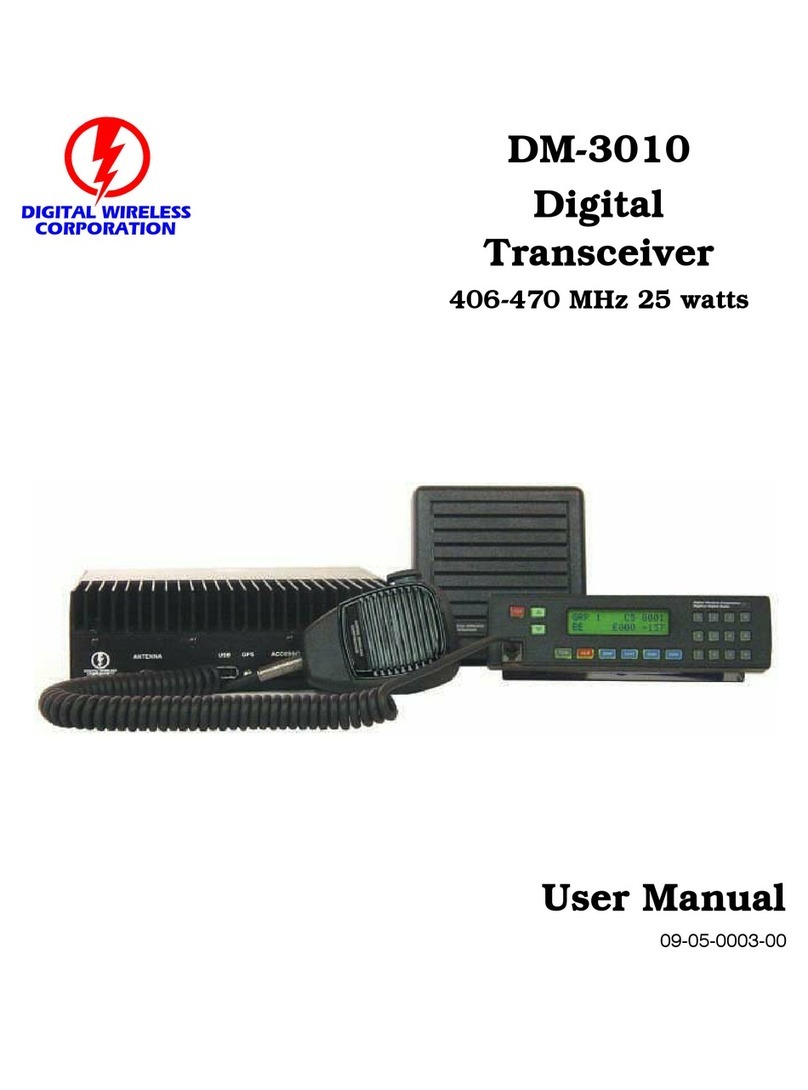
Digital Wireless Corporation
Digital Wireless Corporation DM-3010 user manual
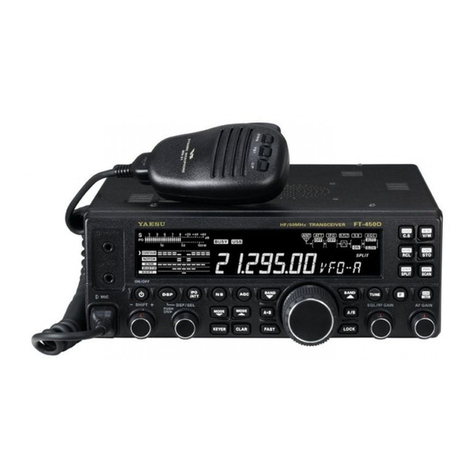
Yaesu
Yaesu FT-450D Operation manual
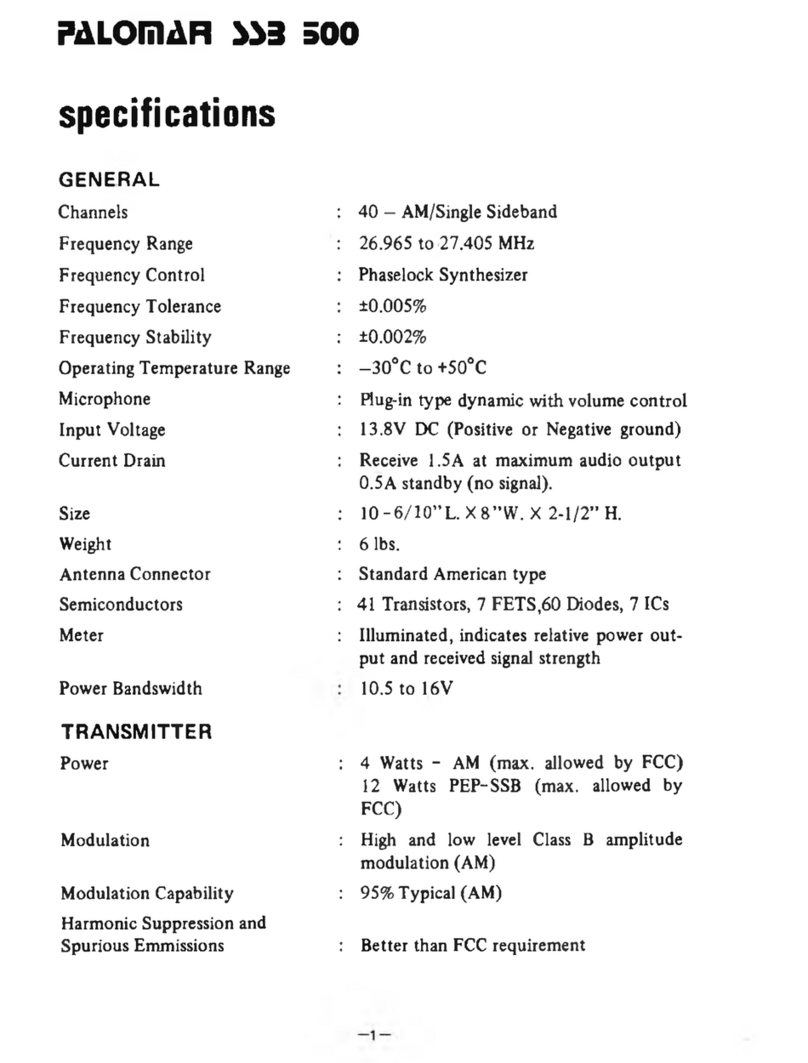
Palomar
Palomar SSB-500 instruction manual

Yaesu
Yaesu FTA-750L operating manual
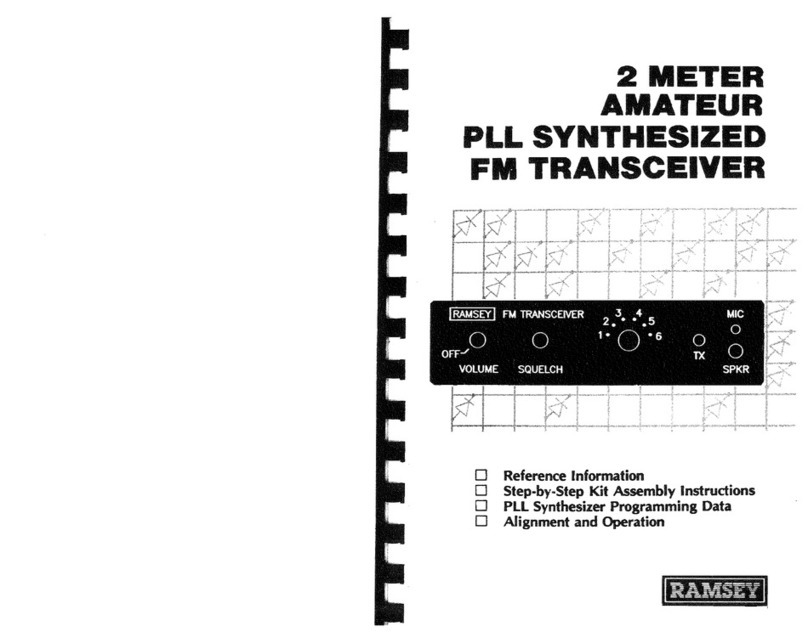
Ramsey Electronics
Ramsey Electronics FTR-146 Kit assembly and instruction manual

R&S
R&S 4200 Series operating manual

